short but sweet
in every job that's to be done there is an element of fun
The most useful designs for children to make are ones that can be made very quickly with no tools and no materials

This can be made out of almost anything, eg a sweet wrapper or aluminium foil . It can be made without sellotape even but you must have a drinking straw and some means of making a hole in it. If you make them one-ended they sound like a steam train. If you have a pin, you can use it to locate the spinner over the hole instead of your finger tip. Stick it through the straw so that the spinner rests against it. Now you can make several on one straw, different types, different directions etc. Attach one to a hat with a bendy straw to blow through.
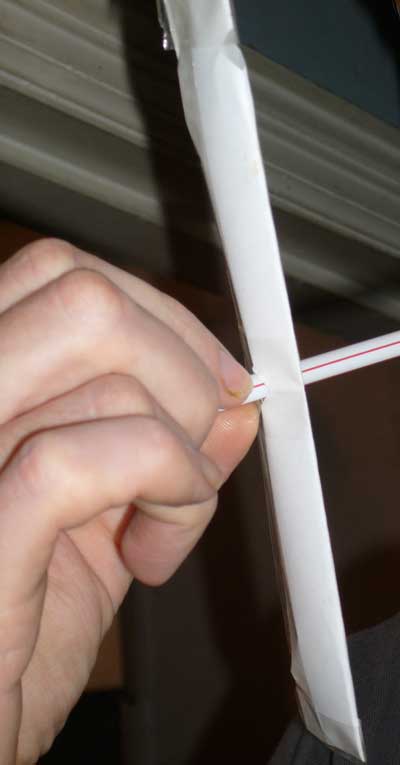
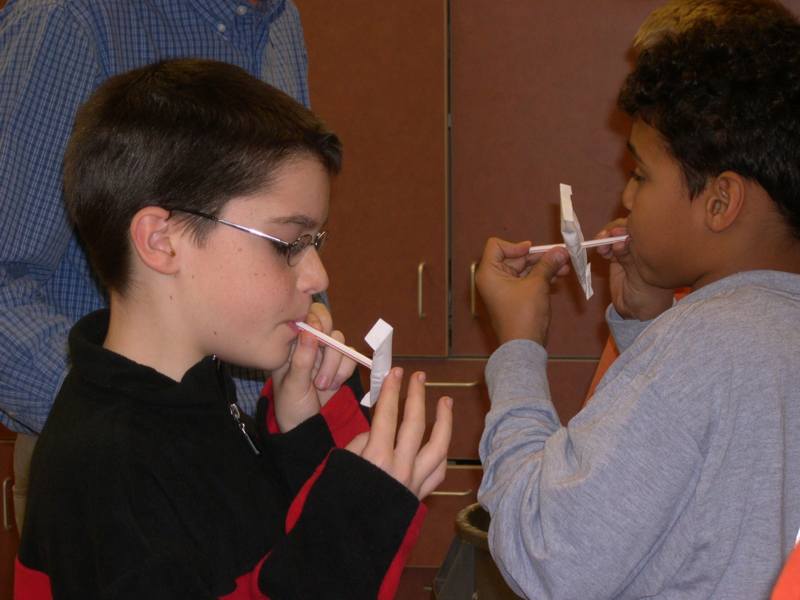
With spinners
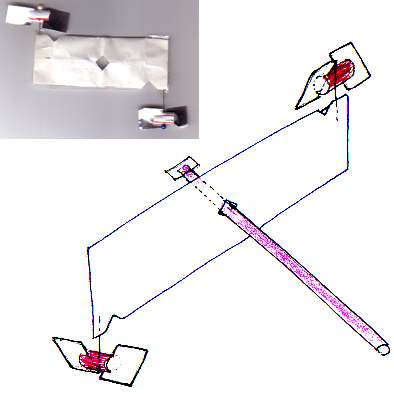
Wingtip streamers are good, too.
This is one with a pen
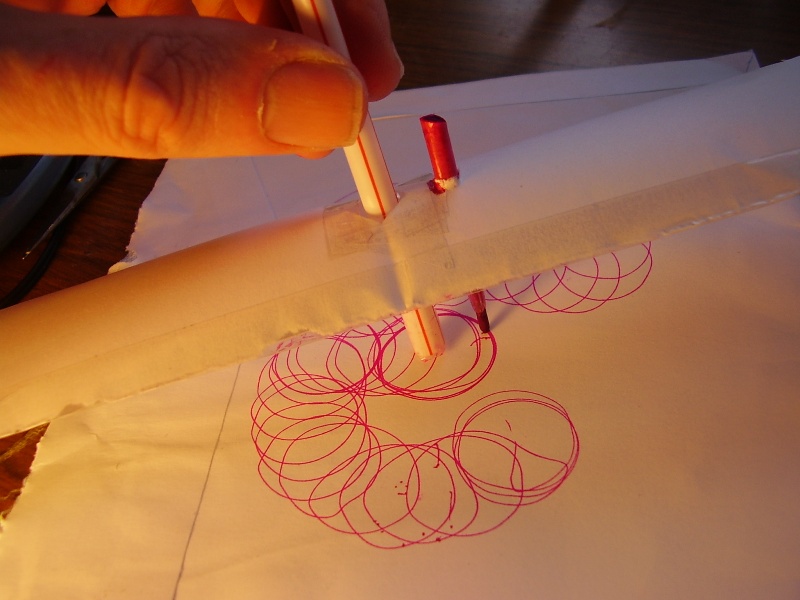
You have to break a cheap felt tip to get the ink tube and the tip. Make a hole near the middle of the spinner & poke the ink tube through
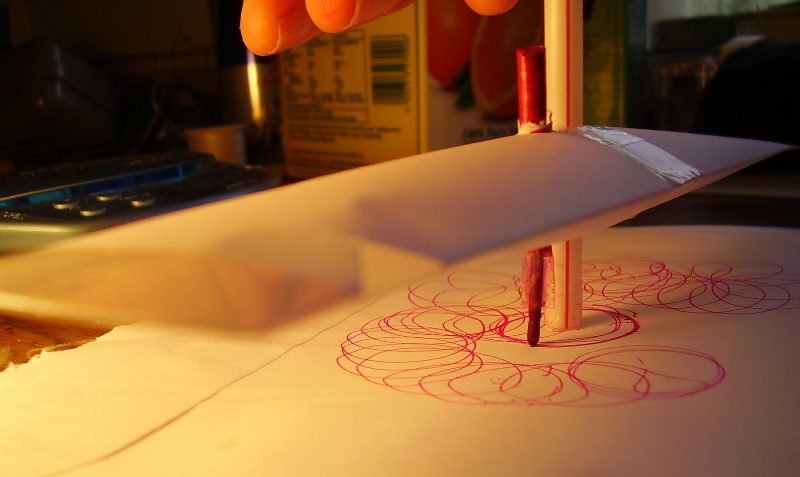
Link to movie
This is a winch, it's a bit more complicated
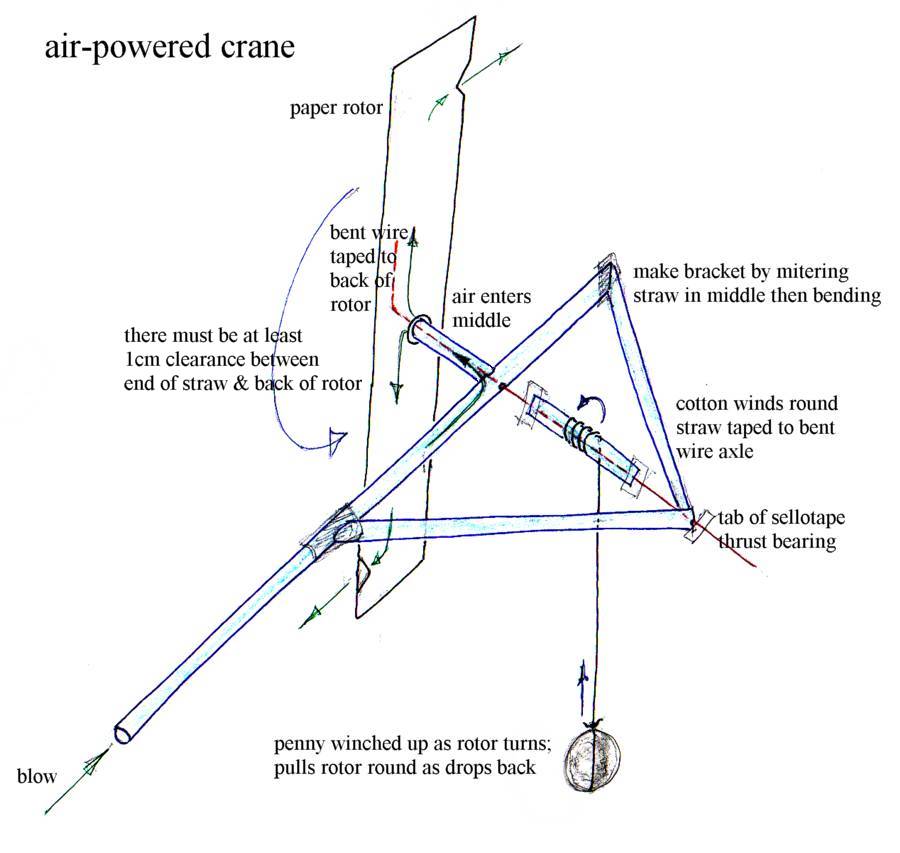
This one works a lot better
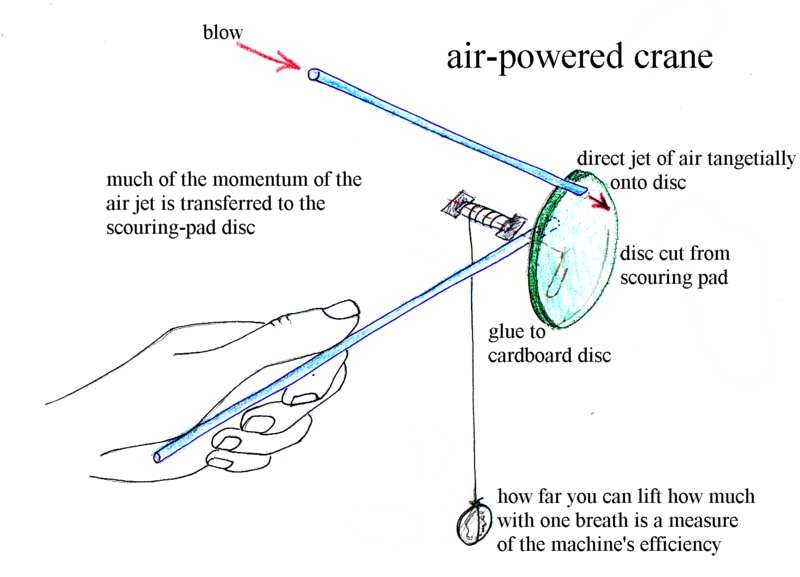
This comes towards you as you blow it away from you
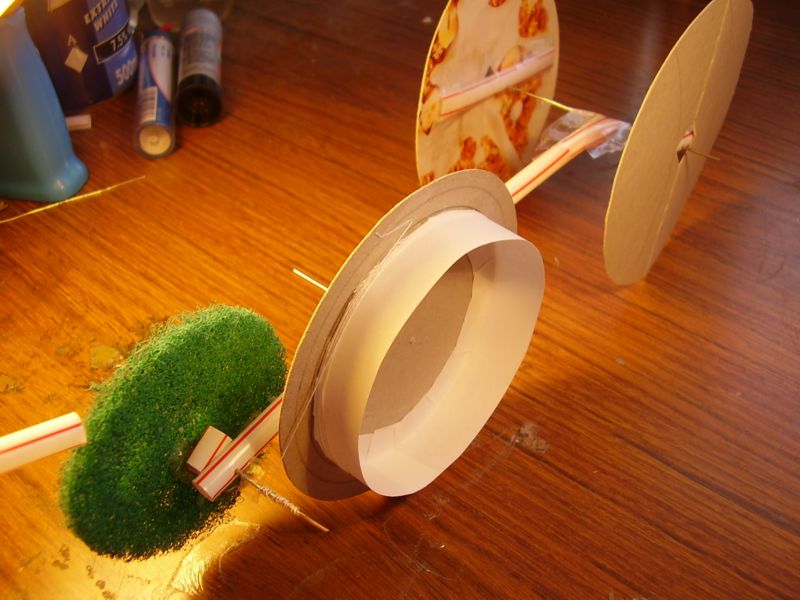
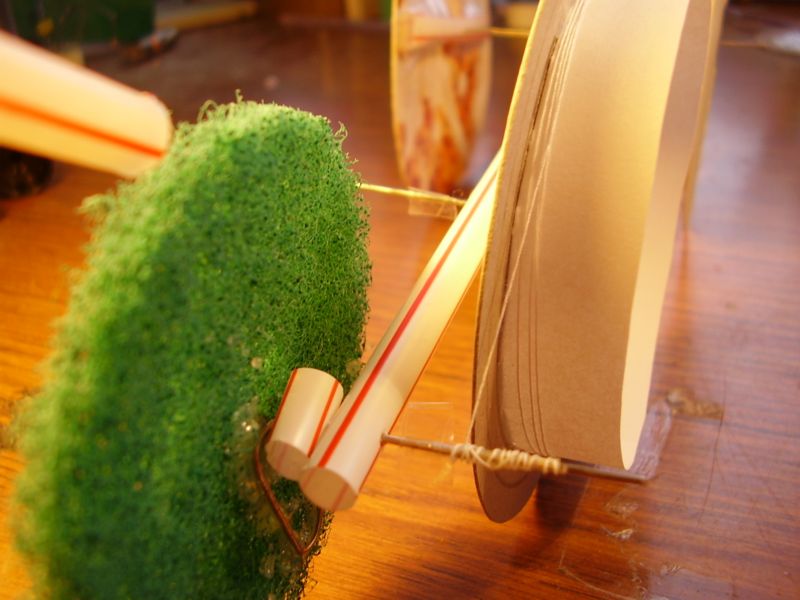
This is a different type, you make it by cutting halfway through two slips of paper
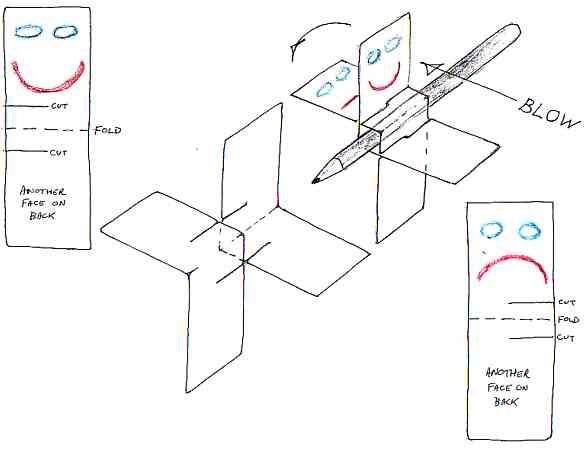
Because it rotates away from your eyes as you blow on it you can use it to make a simple animation, although creating an animation which is convincing is surprisingly difficult.
This one can be made from a plastic or paper cup
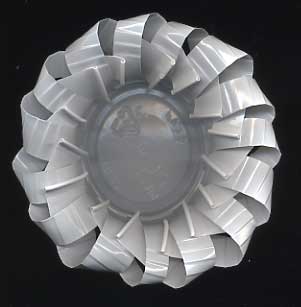
If the cup is made from thin plastic you can cut it with your finger & thumbnail, for thicker plastic you will need a pair of scissors. If you make a small indentation in the middle with a ballpoint pen you can balance it on the pen point and make it spin by blowing at it gently.
These are two simple spinners you can make from drinking straws
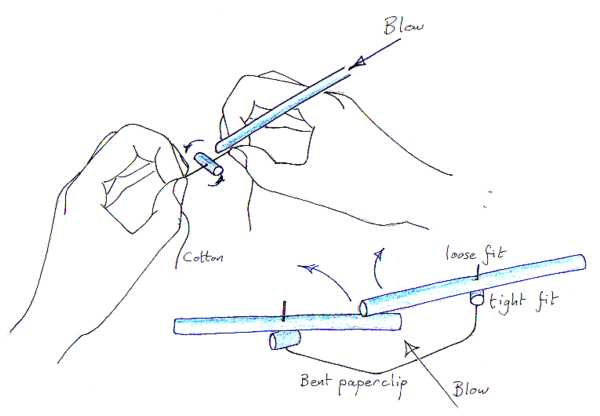
One works by threading some cotton through a very small bit of drinking straw with a needle then stretching the cotton and blowing on the drinking straw with another one used as a blowpipe held in your lips.
The other one works by using a paper clip instead of the cotton, this involves making a hole which is a loose fit on a paperclip. The bits of straw rest on spacers made of more bits of straw which are a tight fit on the paperclip. If you blow in the middle the bits of straw rotate in opposite directions.
You can also do this with a 1cm square cut from a scouring pad. Thread the cotton, bent paperclip or whatever through the middle of the square then blow on it tangentially through a straw.
This is one attached to a laser pointer
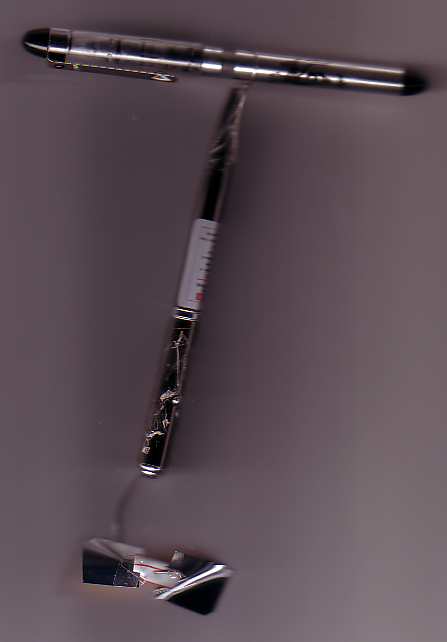
the blades of the spinner are made from mirror-finish inkjet film, they are positioned so that the laser aims at them as they go round. It doesn't work with mirror-plastic because it's too heavy & inertia takes charge. The other end of the pointer is attached to a paperclip which is bent round the barrel of a pen. So that when you hold the pen you can spin the pointer round & round which causes the spinner to turn. You can do it surprisingly consistantly, for best results hold near a wall in a dark room, for truly spectacular patterns whirl it round horizontally in an (empty) bath.
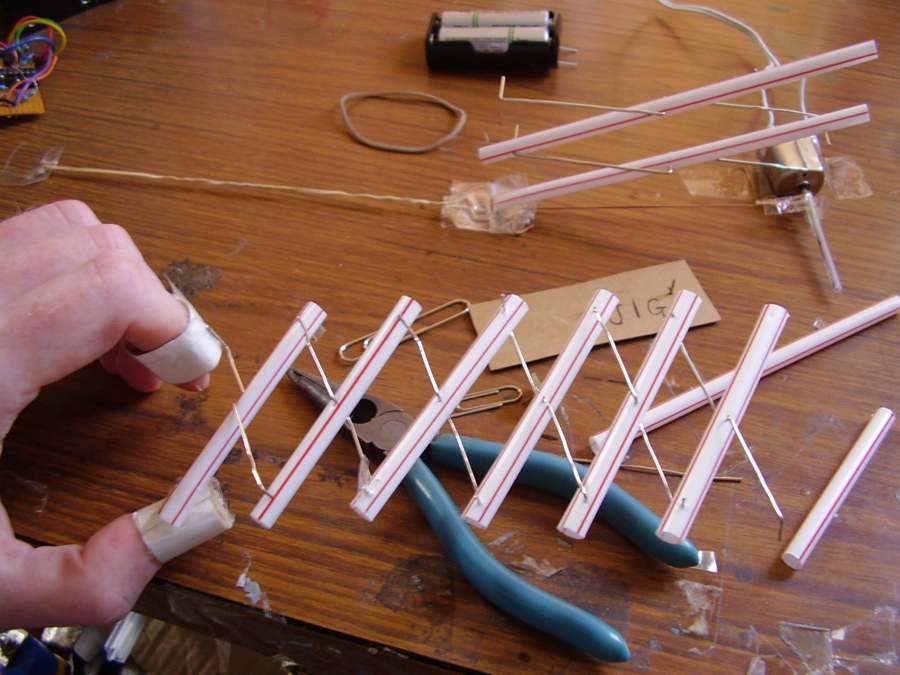
This is aother application for the bearing. The electric version uses a bit of thread twisting round a biro refill pushed onto a motor shaft & rubber band return spring. This is a good way of making puppets move because it's very simple and almost soundless.
You can make wheels like this
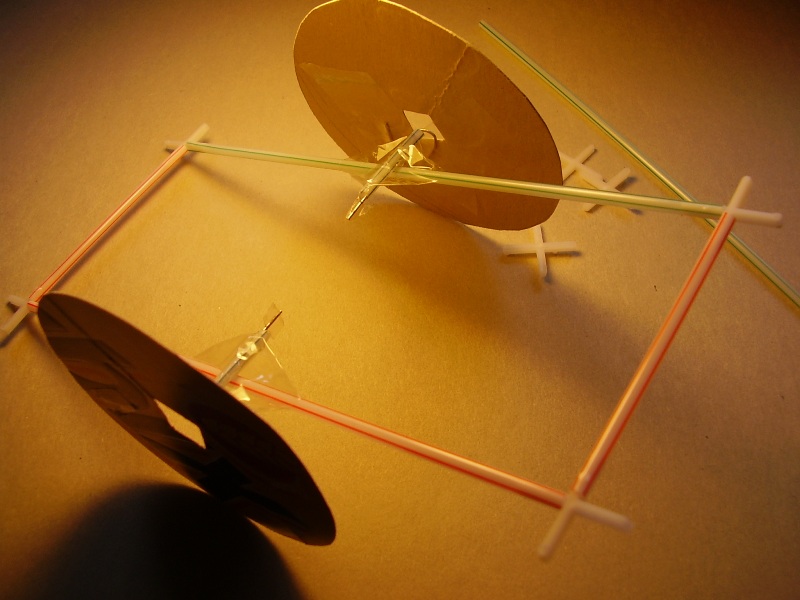
You can attach them to anything light, they will still work if badly made.
The wheel bearings in this case are made of short lengths of thin drinking straw, but they can be made by making a hole the sides of a drinking straw

In practice this is quite difficult, and you need something sharp to make the holes.
This is a detail of a wheel bearing
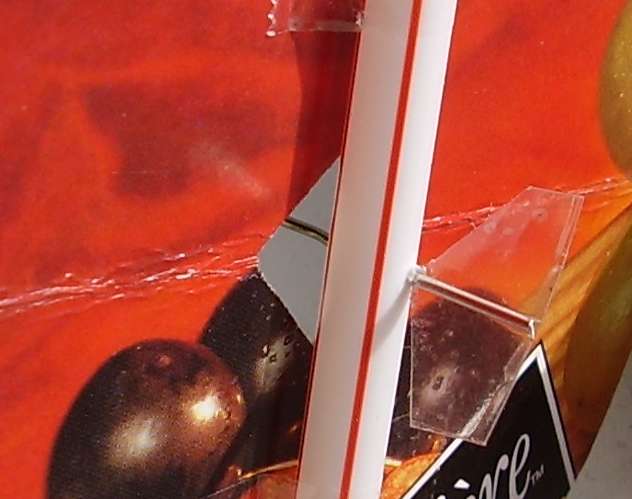
This is a windmill made with three wheels stuck tangentially to a bit of card, you blow it round with a hand-held fan. The wheels need to be quite round for this one
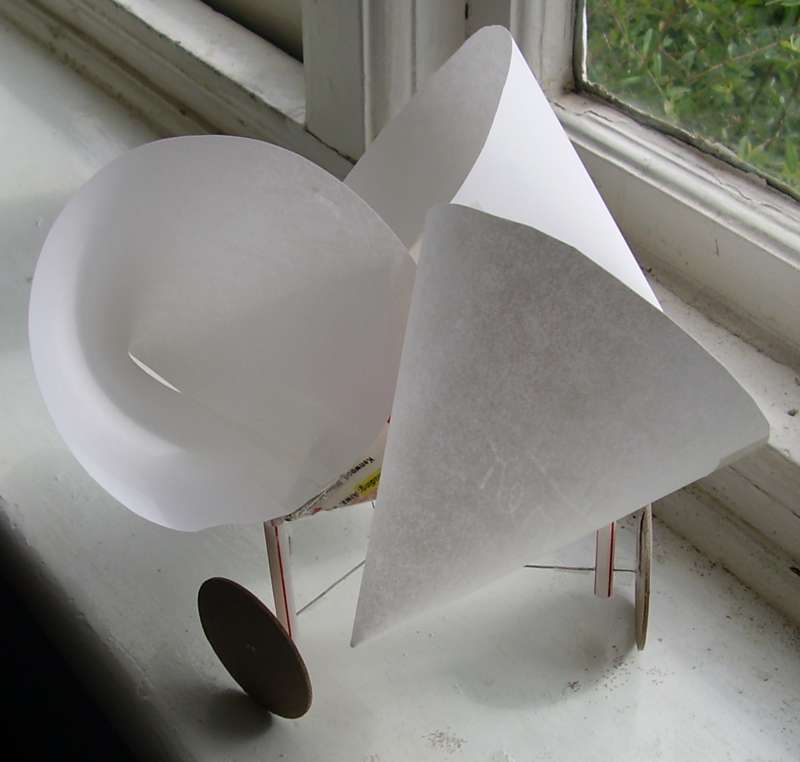
Link to page about rubber-band motors
Link to page about toys made from battery-operated hanheld fans
This is a miniature bangla-deshi spinning wheel made along similar lines
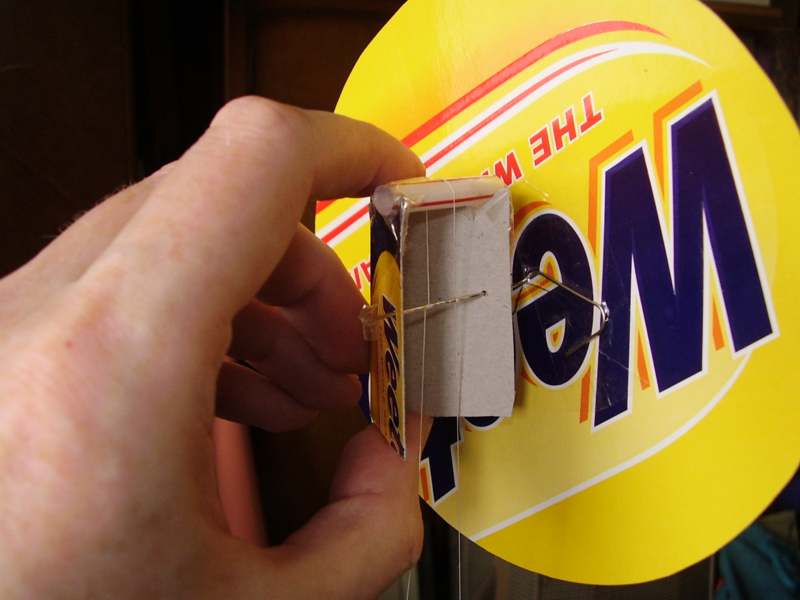
This is a detail
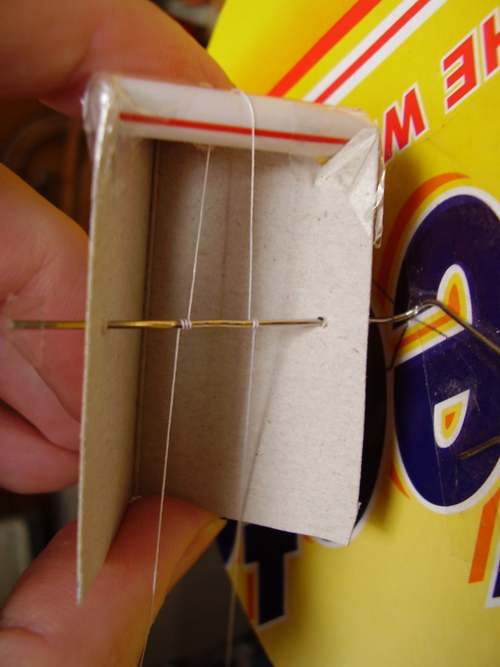
It's operated by two fingers of your other hand
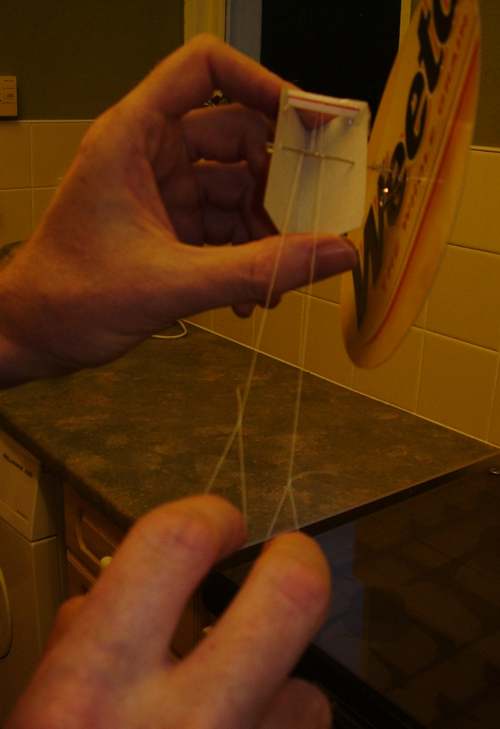
This is how to make a spooky noise with a plastic bottle
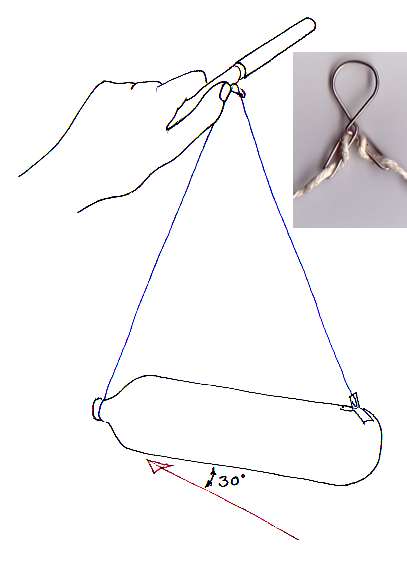
Make the cleat by bending a paperclip, adjust the string so that the bottle has an angle of attack of 30 degrees as you spin it round. The pen lid stops the cleat sliding off the pen. Watch out for light fittings. Good if you put super-bright LEDs on it, put the batteries (2 AAA) at the front of the bottle on the side furthest from the pen. Might be good with a mirror-plastic spinner at the back end.
This is a compressed air motor
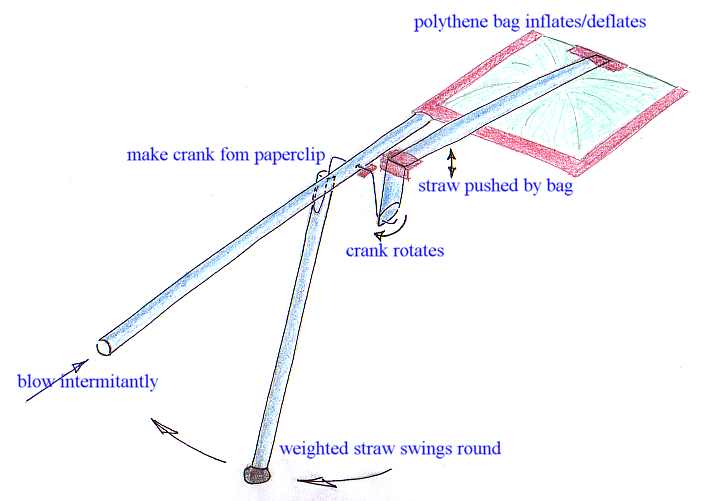
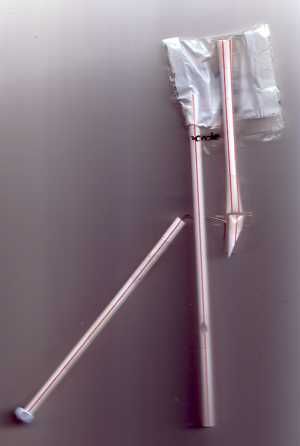
You inflate the polythene bag by blowing down the straw, but only when the weighted straw is swinging upwards. By getting the timing just right you can make the weight go round & round, you don't have to blow very hard, just get the timing right. The connecting rods are joined together with sellotape hinges, the crank bearing is done by cutting the end of the straw obliquely. It is very forgiving & will work no matter how badly made.
read about rotary valves
This is Jeff Bindon's
interpretation of it

You can make them with a valve but they are a lot trickier.
engine animations
A wheel & crank can be made as a separate exercise: it can be driven by a finger-actuated lever
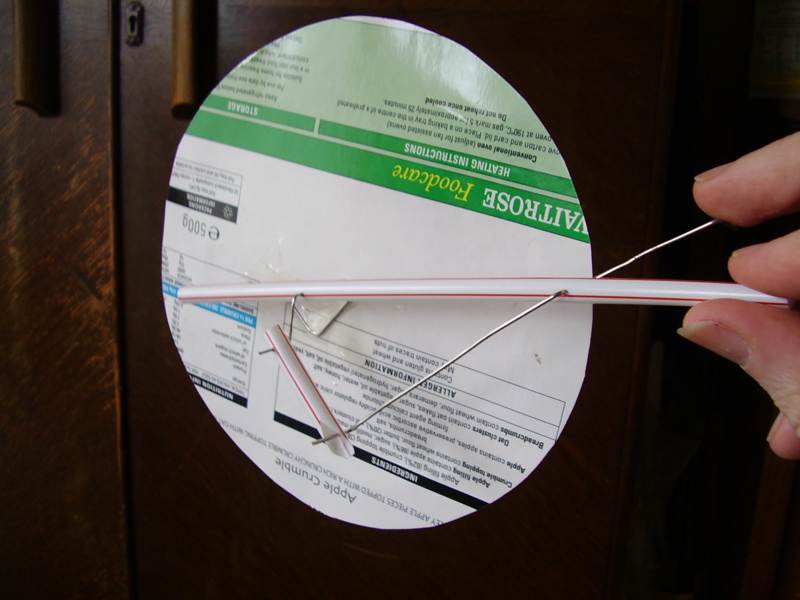
read about the monosoupape engine
This is a design by Slater Harrison
which I've simplified
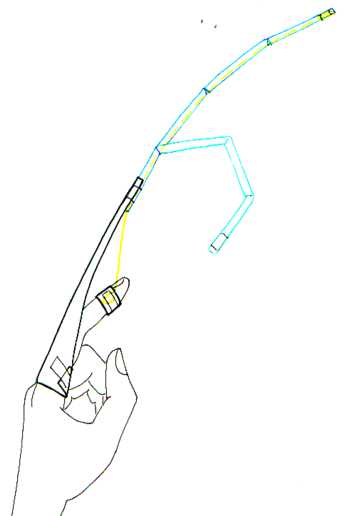
It is made of a drinking straw with diamond-shaped cutouts to enable it to hinge & spring back; it is operated by a string passing through it attached to the finger tip. A folded strip of card attaches the straw to the finger. The string is pulled by means of a cardboard ring.
This is a very small one made from a narrow drinking straw
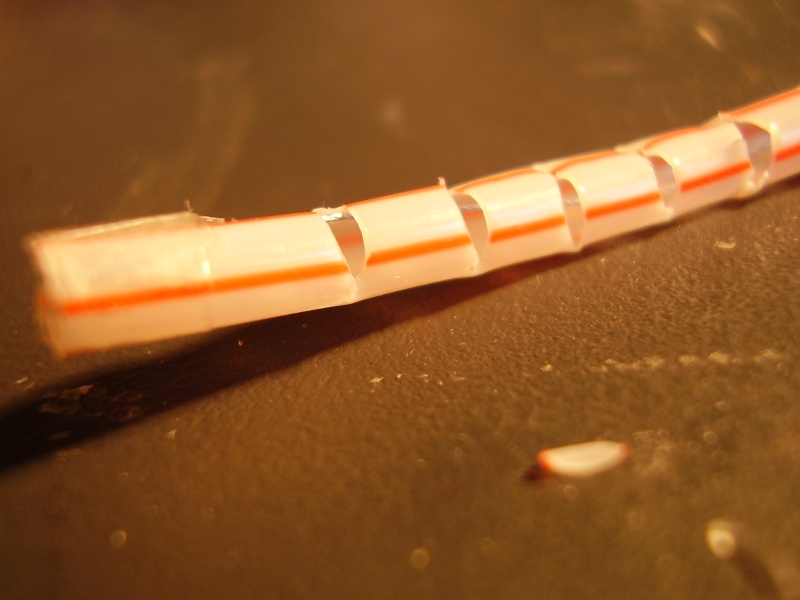
you have to make the notches with a scalpel, use a split straw inserted down the middle to support the straw while cutting. It would make quite a good starting point for a robot design of some kind.
Link to movie
This is a 'musical instrument'
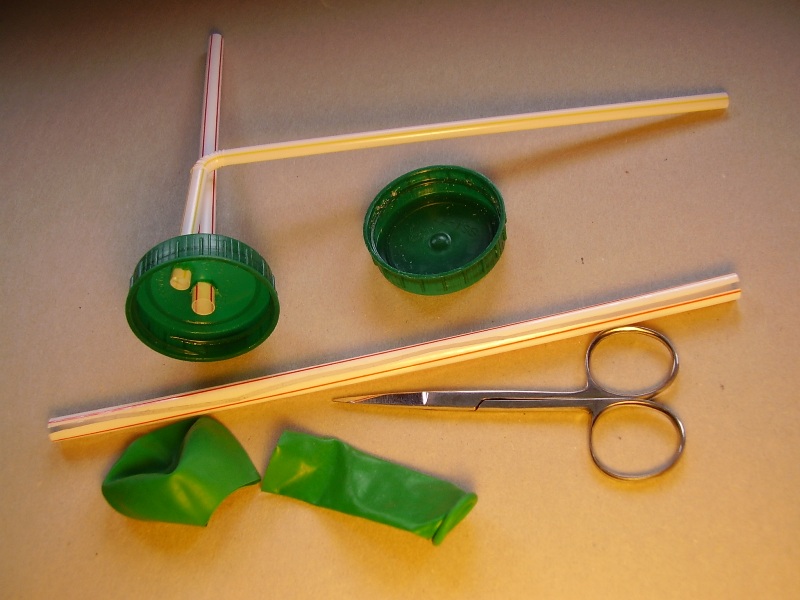
The diaphragm is stretched over the plastic milk jug top; the straw which has been split along its length is repaired with sellotape so it will slide over the other similar straw to make a trombone action
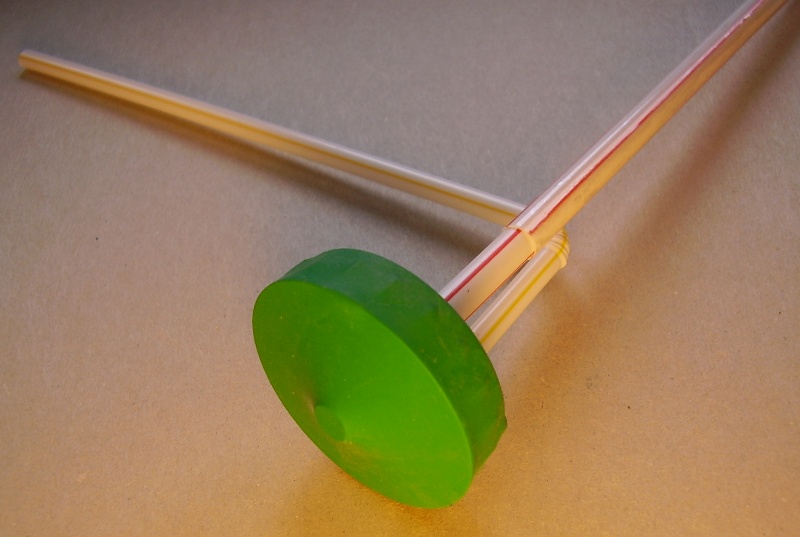
You blow in the bendy straw, slide the other one to get 'music'.
Make your own Oboe
Balloon powered organ movie
This is Jeff Bindon's design for a cartesian diver
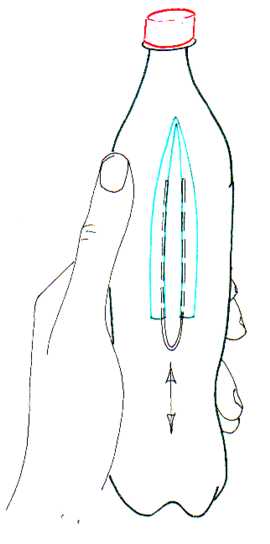
made from a folded drinking straw and a bent bit of fence wire, it goes up & down as you squeeze the bottle. You have to make it just positively buoyant by cutting off bits of wire or drinking-straw. Jeff sells this as a very child-friendly kit. Every kit comes with a deceptively succinct little pamphlet. This is his explanation of why things float or sink
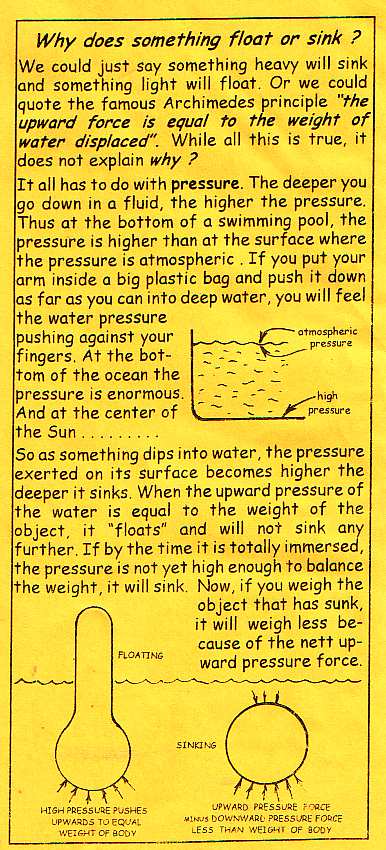
and this is his latest design
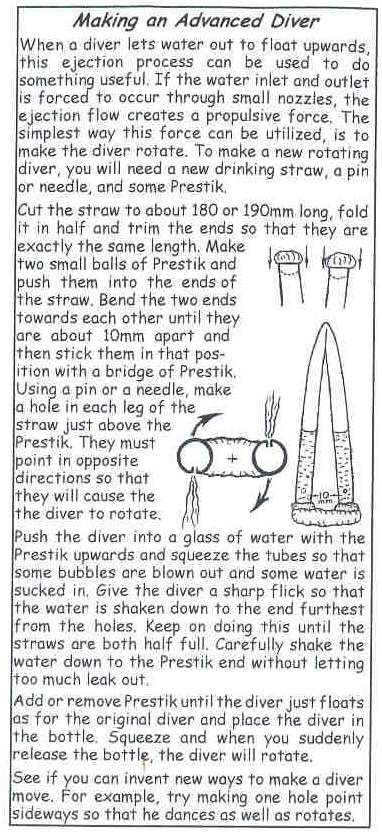
It's not only more interesting but it is also easier to make because you don't need the wherewithall to cut & bend wire. Blue-tack is more expensive to buy than wire but cheaper to use in terms of skills. Imparting skills uses up resources.
This is a way of writing with two pens at once
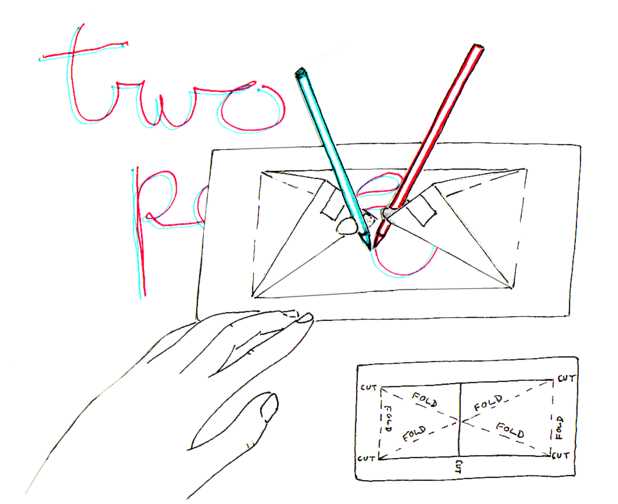
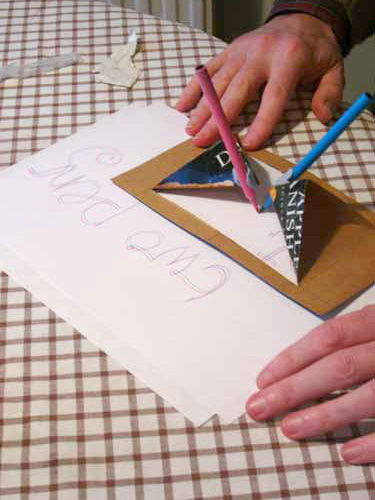
You blue-tack two felt tips to the swinging arms formed by folding the card. Try to get the tips close together but not touching. I think it's probably possible to modify it to work with more than two pens. You can use it at the end of a harmonograph arm.
This is a sycamore made from a juice box

It has a wingspan of about 6". If a straw is pushed into the central diamond-shaped hole it assumes an oval shape, it can then be secured by a small tab of sellotape over the top. You need either a sharp knife or some nail scissors to make the hole. Because the top of the straw keeps an oval shape it keeps its strength and can transmit a lot of twisting force to the wing as you rub it between the palms of your hands. Be sure to make it right (or left) handed.
make a ringwing. Much easier. It will work.
This is two ways to pop a balloon
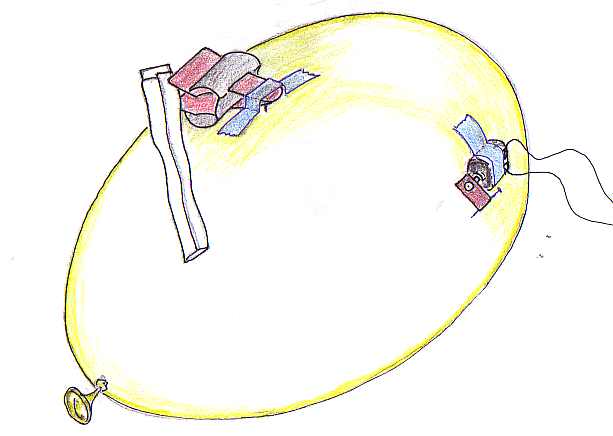
One is a timer made from a lump of sugar held in a paperclip, there is a drawing pin held against the balloon by the handle of the clip. The sugar lump is wrapped in a paper towel which is dipped in water, when the water soaks up the towel it dissolves the sugar lump & the pin is pressed against the balloon.
The other is a pin mounted on the shaft of an electric motor by means of a small slip of card. Use lots of AA batteries for reliable results.
You have to get very scientific with the paper towel to get a consistant time interval, it should be possible to do 2-3 minutes with reasonable consistancy. This can also be used for kite photography, the clip presses on the shutter button of a throwaway camera rather than on a pin.
Because a balloon is quite strong it can be used to support something else eg a bundle of books tied to a party popper etc. To do this you really need a bit of wood with a hole in it to support the party popper above the books. You can support the bit of wood across the top of a door and the moulding across the top of the doorway. I wonder about using the balloon to hold the strings of lots other balloons by means of a rubber band round its middle: send it aloft by a kite string or helium balloon, then I suppose you would get a cloud of catchable balloons coming down when the timer went. Haven't ever tried it.
similar idea
This is a spinner that works from the heat of your hand

Make truncated paper cone, put bit of drinking straw through near top, stick pin through straw so projects through top of cone, make propellor by folding slip of paper diagonally, balance on pin.
This is how to use your hands as a pinhole camera although it must be said not a very good one
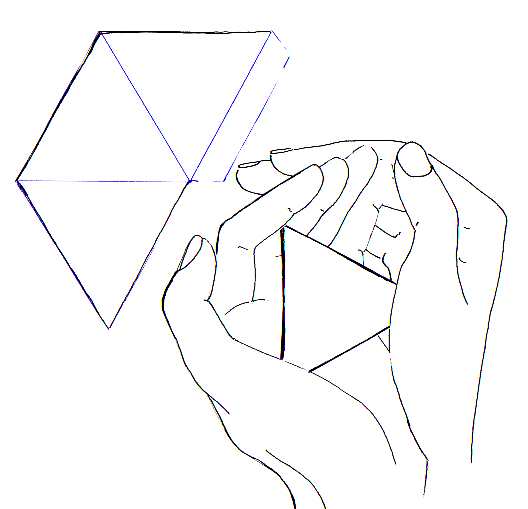
Make a paper tetrahedron about half the width
of your hand, make one surface from tracing paper, smooth tissue paper or thin polythene, cut off tip of opposite apex to create small hole, hold in hands as shown with hole projecting between your hands. Use your hands to block most of the light from one eye, point camera at window, look at back surface of tetrahedron. Only works in bright sunlight.
This is how to blow smokerings using a joss stick & a paper cup
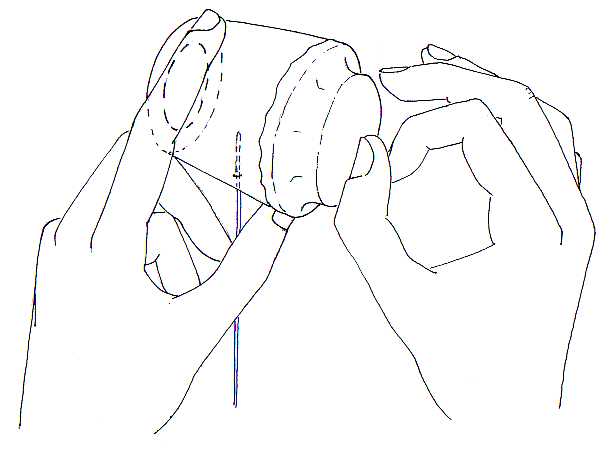
Make a hole in the base of the cup about half the overall diameter, make a diaphragm from a balloon with the neck cut off and a disc of card superglued to it while stretched tight over something round & more robust than a paper cup: pre-stretch the balloon by inflating & deflating it. Make hole in side of cup for burning incense stick. Put diaphragm over mouth of cup & flick very gently. Makes smokerings about 2 inch diameter typically go 2-3 ft, often you get several at once, it will work with a much less sophisticated diaphragm but not so well.
This is a bigger version made from a large margarine packet
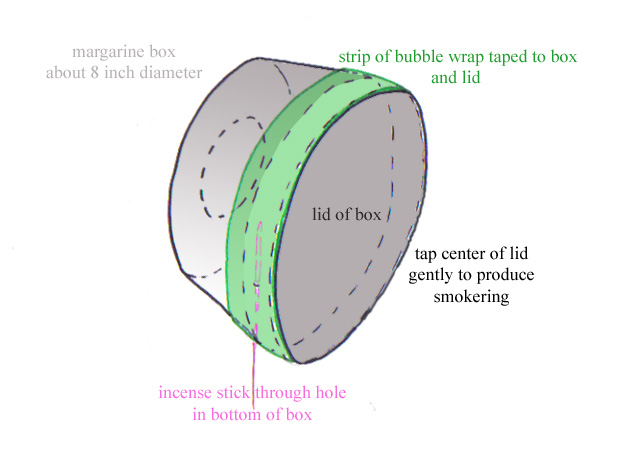
A strip of bubblewrap is taped to the box and to the lid so that the lid can move relative to the box when tapped, it makes bigger smokerings, this method also works with a paper cup, it seems that if the whole end of the container moves simultaneously you get better smokerings. Exactly what kind of smokering you get depends on how the lid is tapped or flicked.
Smoke photography
Make a large vortex gun from a plastic bucket

You can make one of these with a glass marble
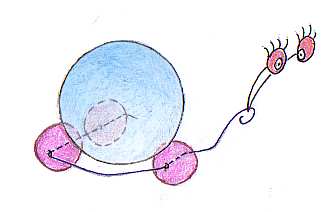
bend paperclip, thread on three plastic beads as shown, rest marble on beads so that when you pull the paperclip the marble rotates in the opposite direction from that in which the vehicle is moving. Make head from bit of string, paper eyes etc.
make a marblemouse
This is a thing like a billiard cue for marbles made from a bit of bamboo cane from a window blind
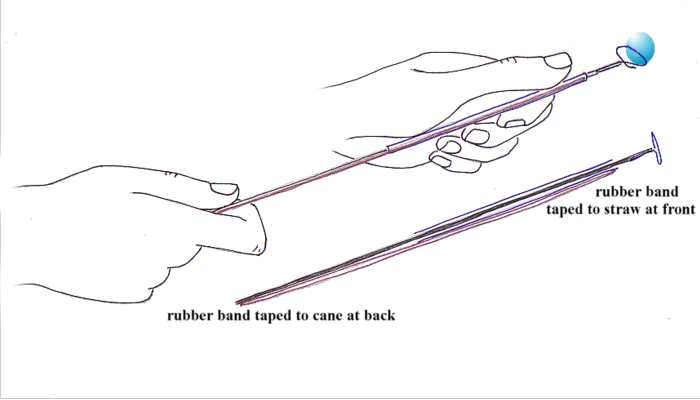
it is powered by a rubber band, the cane slides through a drinking straw & pushes on the marble with a paperclip bent into a ring. Transforms marbles into a very long range game, for example you can flick a marble across a smooth floor into a skirting board and it will bounce exactly back to where it started. May be possible to modify it for use as a throwie thrower.
Link to marble runs
This is a cardboard wheel with a hub made from four or five bits of split drinking straw taped over each other, it needs to be quite strong.

Pull the string to spin the wheel then push it off the bent wire handle with your thumbnail. Aim for a gap in the furniture. I don't know what the size limit is.
This is the same idea but it flies
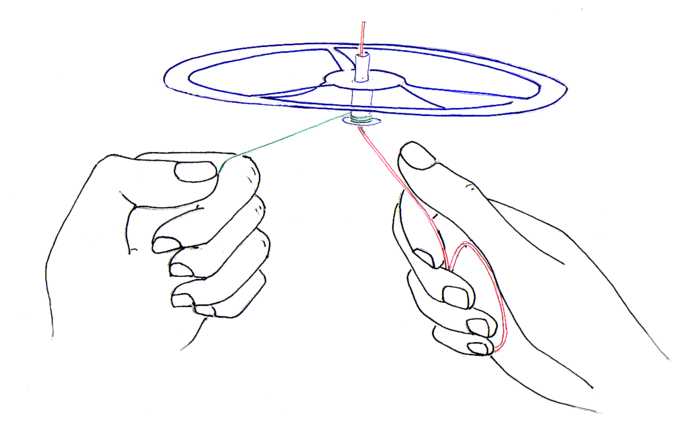
It works with three, four or six rotor blades. Cut from thin card
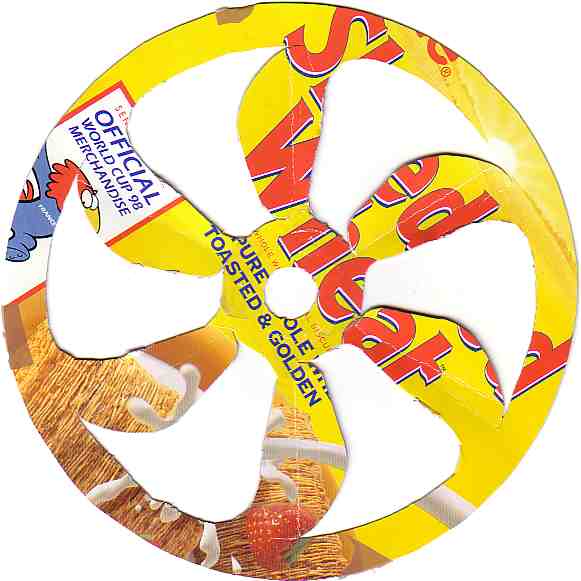
bend the trailing edge of the rotor blades down to an angle of about 30 degrees with a curved cross-section. I found I had to add a small cardboard ring to prevent the string slipping off the hub when you pull it. Mine has a diameter of about eight inches but they prbably work bigger or smaller. It might be worth varying the width of the rim.
This is a UFO

It needs a lot of adjustment to make it fly right, also good breath control. The shape & dimensions of the box seem to be quite important. What air gets up to inside boxes is nobody's business. For beginners splay the nozzles out very slightly. More advanced piloting can be done with the nozzles exactly vertical. Each nozzle should be under the edge of one of the cuved-in sides.
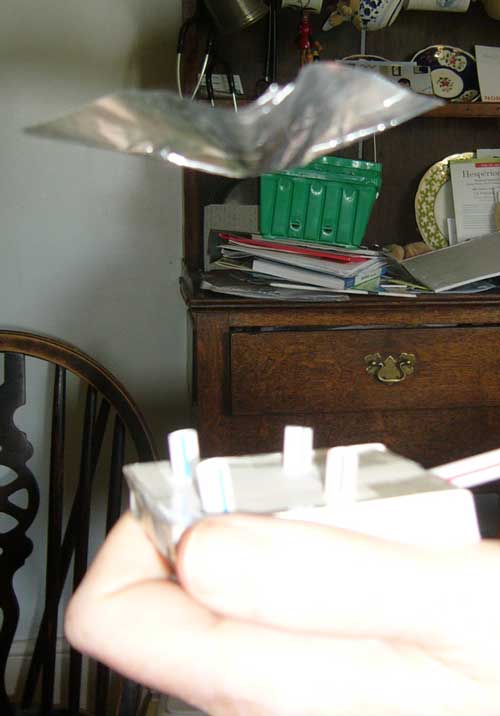
This is a much better way of making it
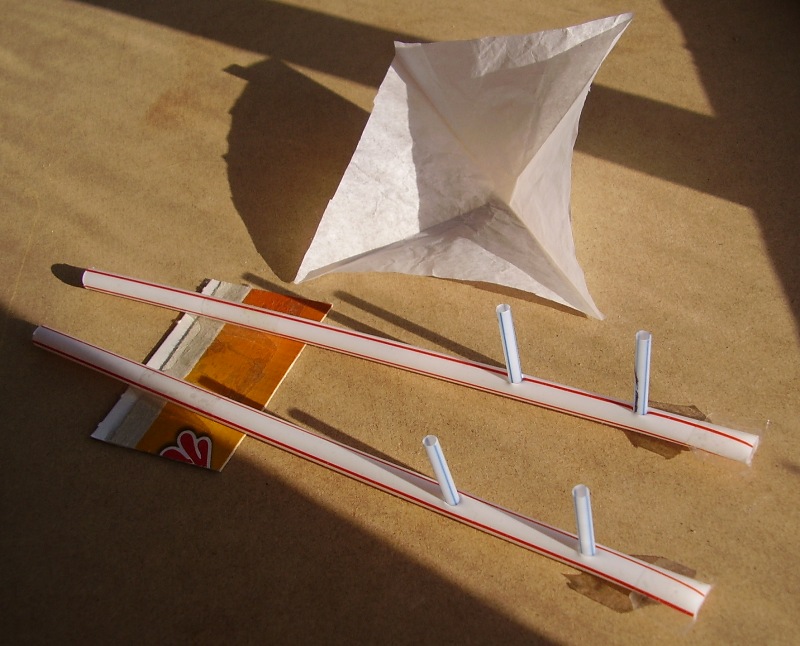
You need two wide straws and one narrow one to make the nozzles. Blow in both straws simultaneously, the other ends are closed off with sellotape
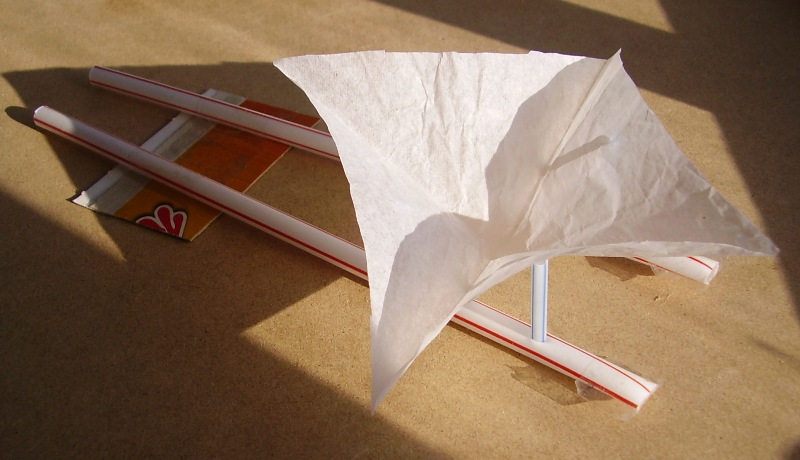
This is much easier to make and much more reliable than the older design; you still need to adjust the nozzles carefully to make it hover right. If they are adjusted wrong it has a rapid pitching motion or flies crooked.
This is a helicopter-parachute
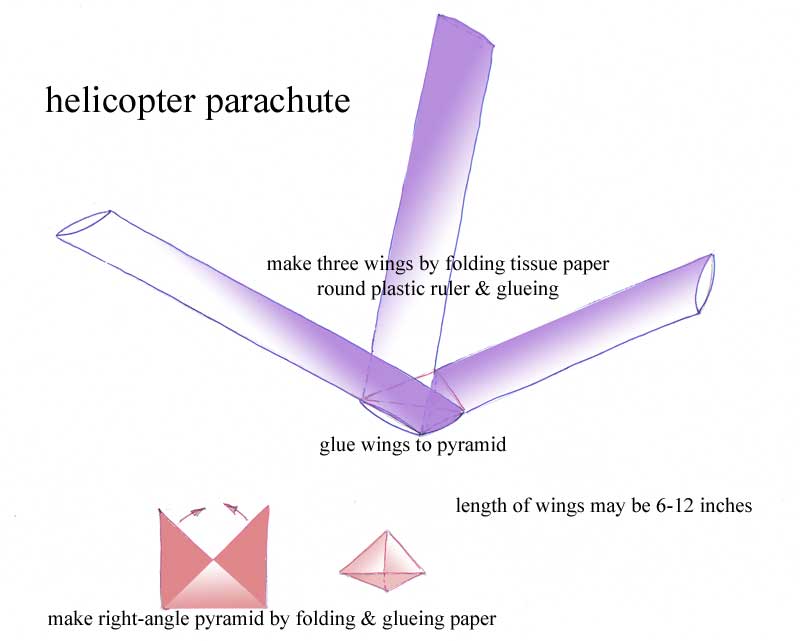
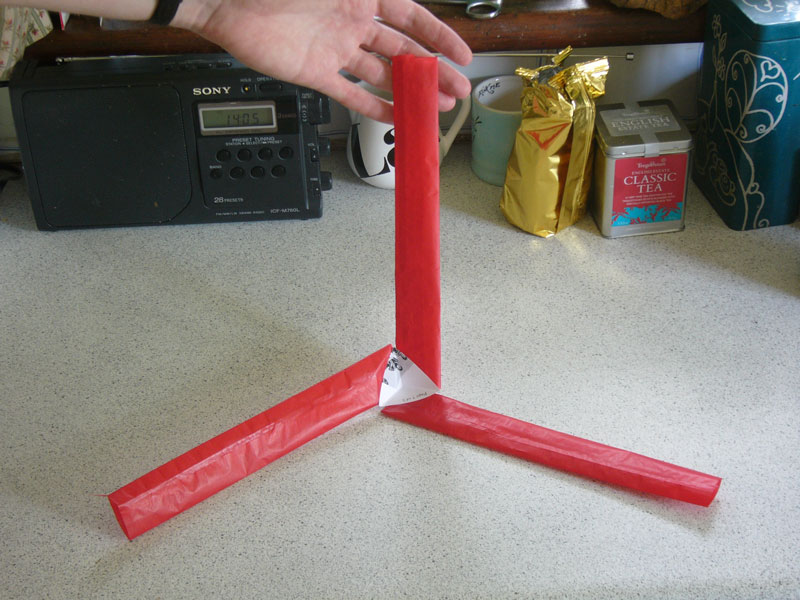
movie of paraheli
this one works a lot better & is very simple to make. Doesn't need the paperclip
This is how to put a screw through a bit of wood inside a bottle
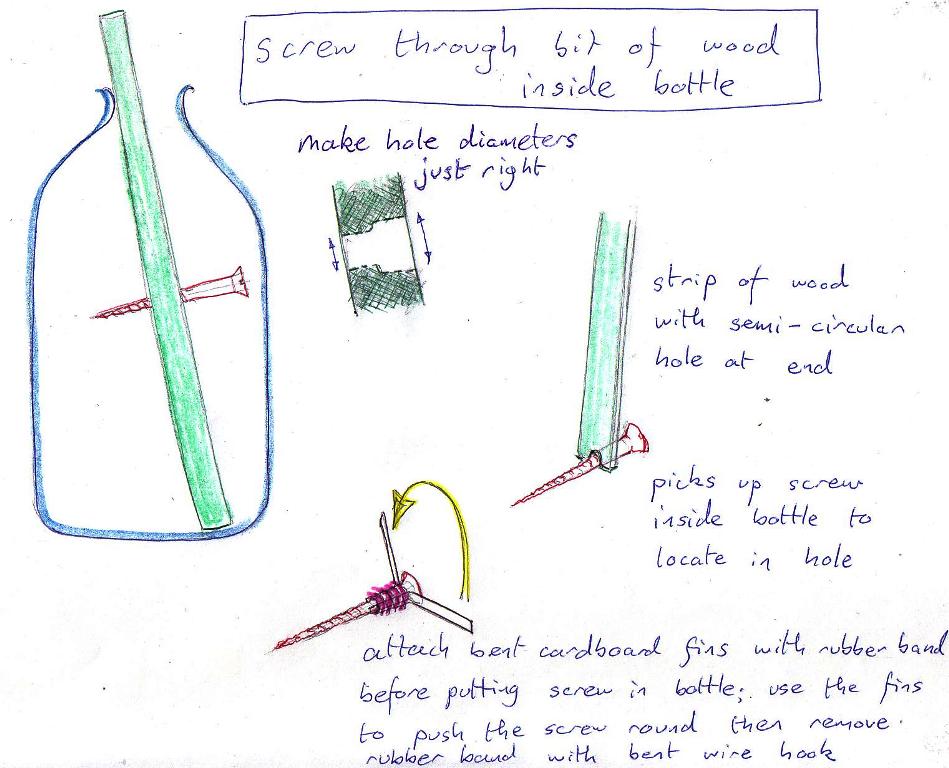
YouTube movie how to assemble a rubik's cube inside a jamjar
This is a universal joint made from bendy drinking straws

If you constrain the bend in a bendy drinking straw and twist one end the other end twists too. Here the constraining is done with two small bits of larger-diameter straw taped to a paperclip bent into a right angle

If you join several together one will turn the next and so on, what happens exactly depends on which constrainers you constrain

The limit seems to be three corners, after that the twisting force gets too much for the bends.
Movie
I now realise you can constrain the corners by putting straightened paperclips inside the straws & then bending them into rightangles, this is much simpler to do
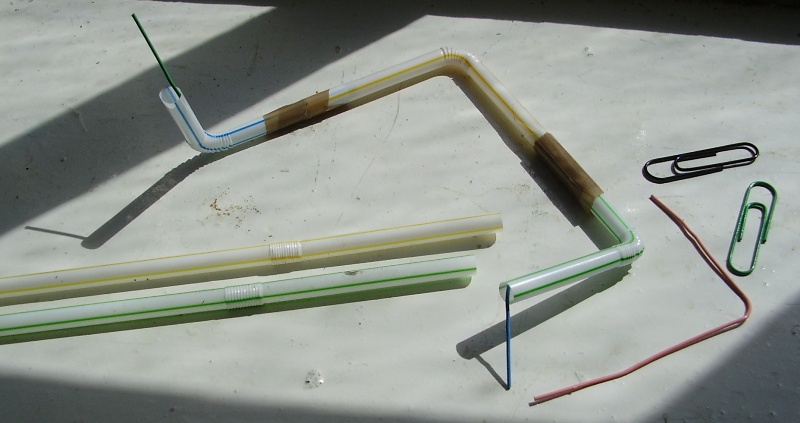
read about the robotic cheerleader
make a universal joint differential
This is a magic cone
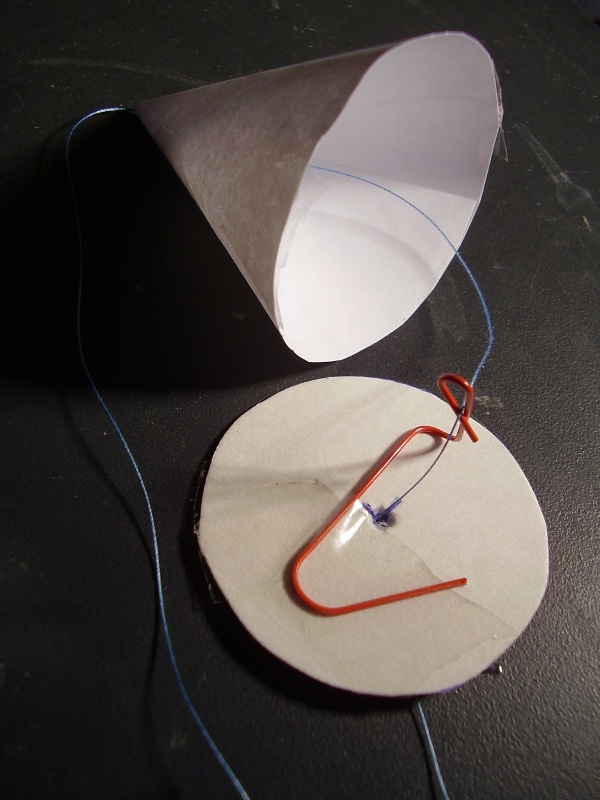
You hold the bottom end of the thread against the ground with your foot, and adjust the tension with the top end held in your hand

You can make the cone fall or not fall apparently when you tell it to.
This is a very primitive form of clock
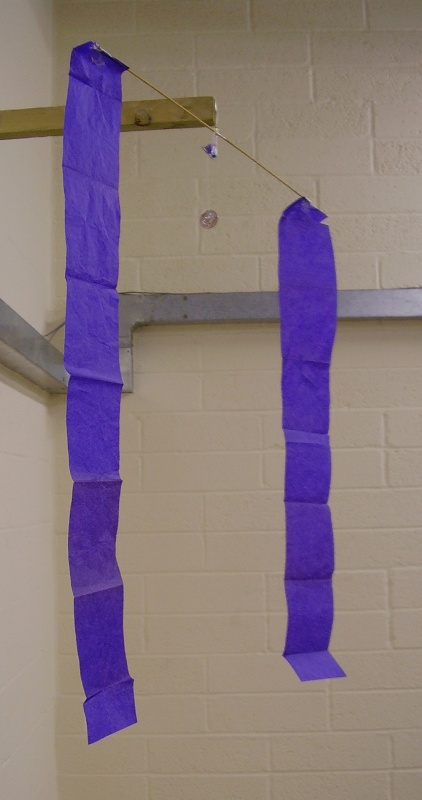
The weight of a penny pulling on a thread makes the streamers rotate very slowly, I could get this one to turn once a minute
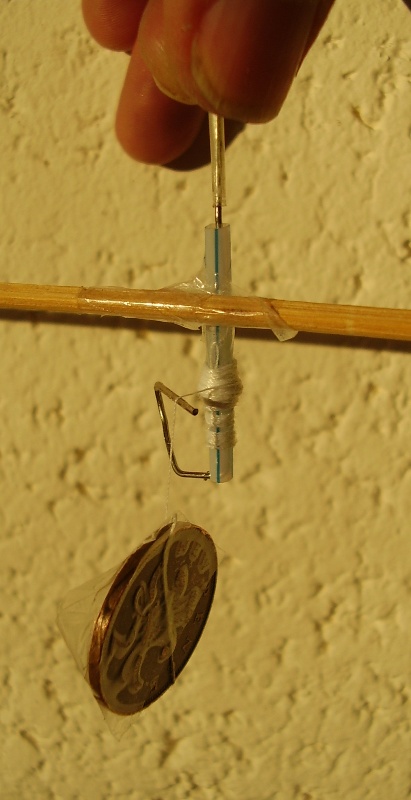
The cotton pulls the bobbin round.
This is a similar thing driven by a rubber band
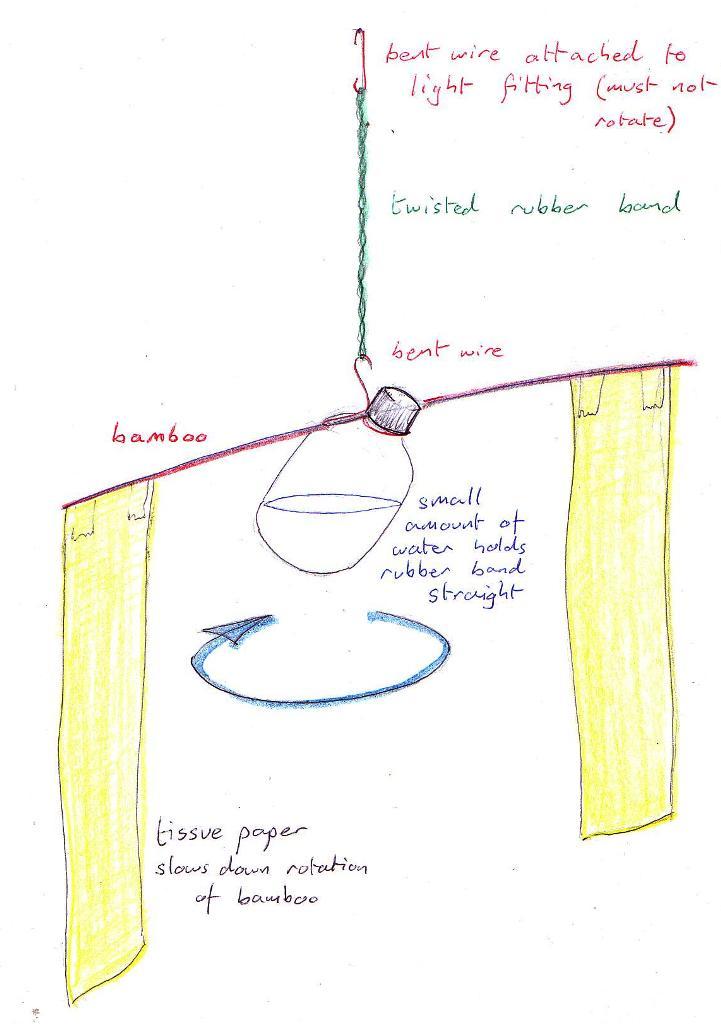
Because the turning force of the rubber band will diminish as it runs down it probably isn't as consistent as the one driven by the dropping weight, but I haven't checked this.
Link to more complicated clock mechanisms
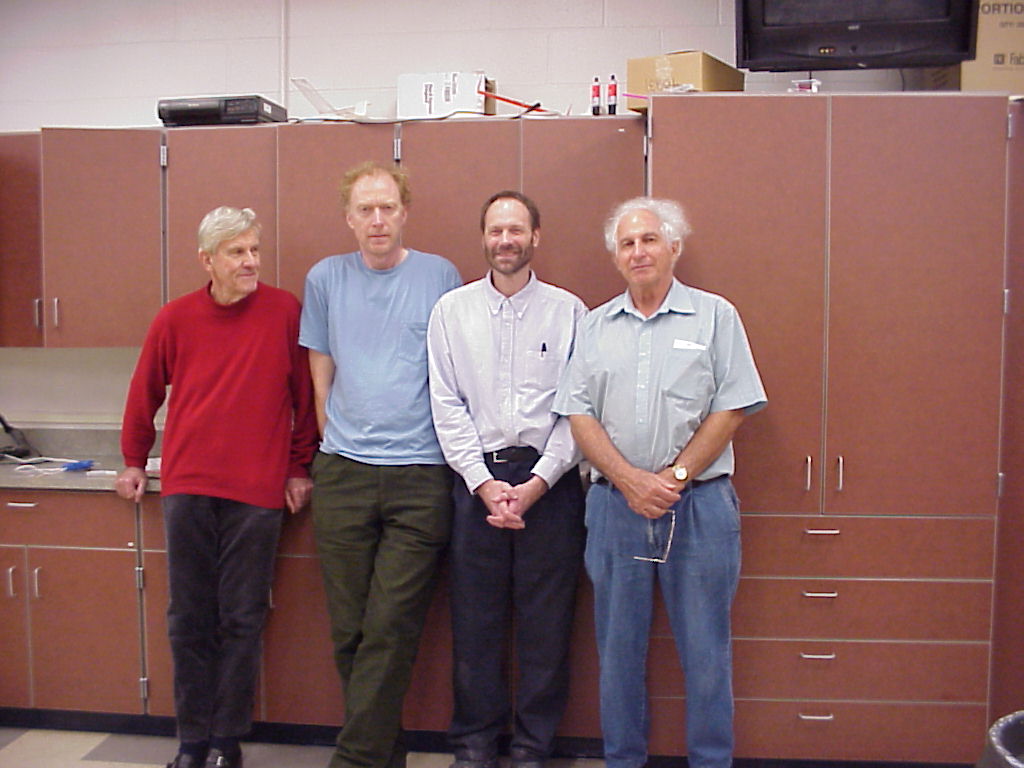
there is no 'i' in 't-e-a-m'
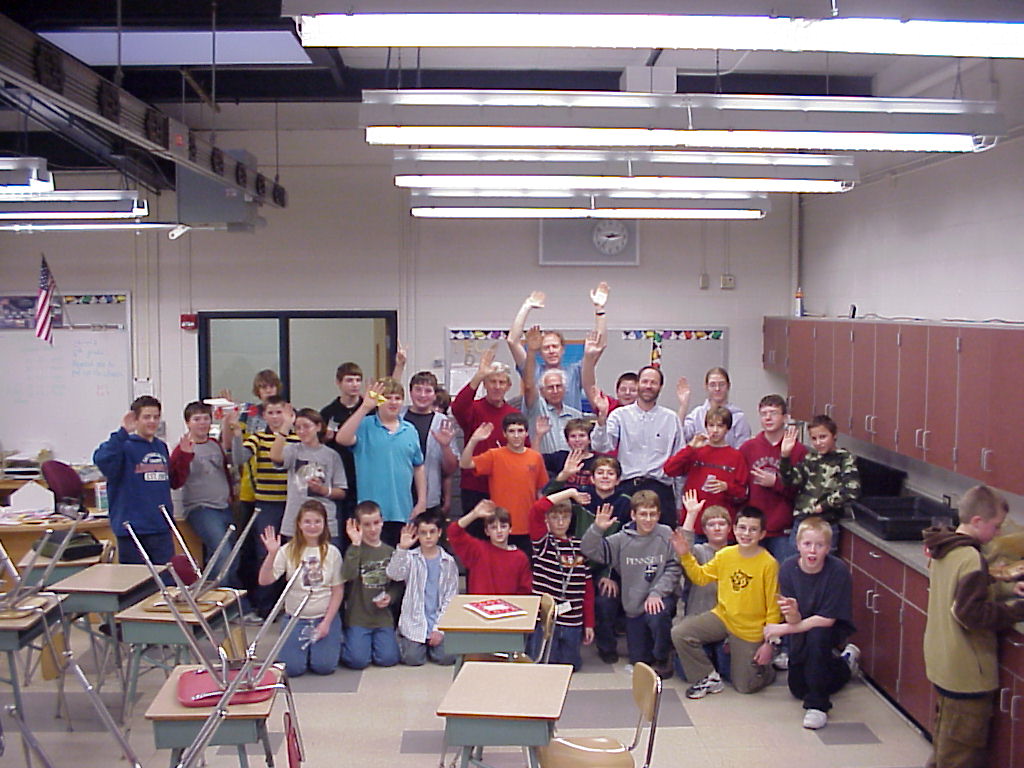
watch the movie
toys from trash site
triacontahedron
walkalong glider
walkalong glider movie
flying cylinder
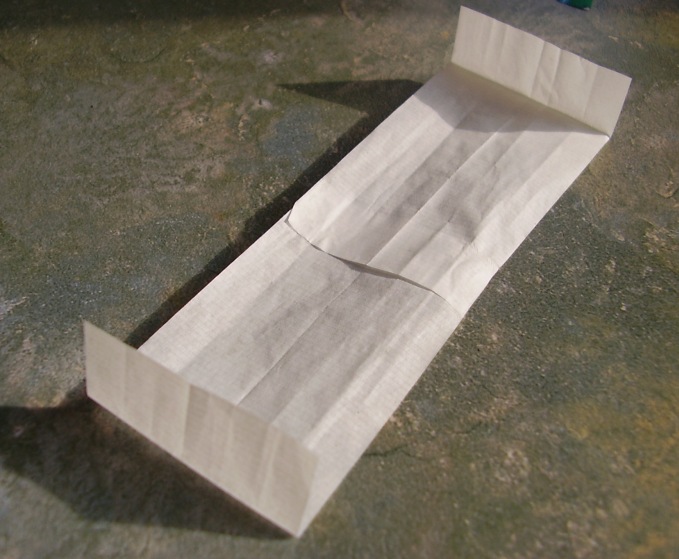
Walkalong glider made from two cigarette papers stuck together
pop-up book
more pop-up books
finger boomerangs
instructables.com 3d paper snowflake
shoemaking
read about wind generators
WannaLearn.com
instructables.com jacob's ladder
strange paper toy
wooden bicycle
my email is davidvwilliamson@hotmail.com
back to main site
































































